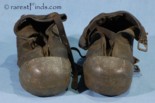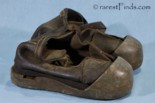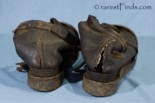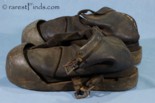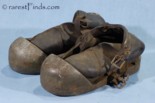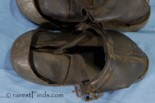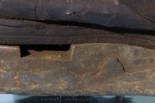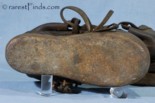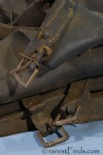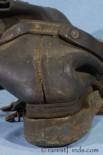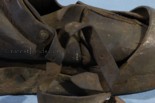Rare Antique Deep Sea Diver´s Boots or Shoes, Price, $650
Real antique, not reproduction, deep sea diver helmets are rare, but shoes or boots are even more difficult to find.
I never had the opportunity to buy any deep sea diver shoes before. These are the earliest boots or shoes I could find online by Googling the subject. Each shoe or boot weighs 21 lb. The bottom and toe cap are cast in bronze as one piece. At the bottom, there is lead applied to the soles; probably to get the right weight for the diver wearing them? Sea pictures # 7, 10, and 11, showing the transition from lead to bronze. The bronze has a very dark patina. Besides the buckles, there is nothing magnetic on these boots. I could not find any manufacturers name on the leather boots or castings.
Condition:
As previously mentioned, the bronze castings have a dark color patina. The leather is stiff and bridle. One of the top shoe is separated from the rest; it can be stuck to the bottom to make a nice display. However, do not expect these shoes to be worn! These shoes of museum quality are just for display purposes.
History:
Polish inventor Heinrich Klingert was the first to develop a full-body diving suit in 1797. The suit consisted of a metal helmet, wide metal girdle, pants, and a vest made of waterproofed leather. With the use of a pump turret, air could be supplied to the diver via a long, weighted tube.
It was not until 1837 when the next leap in diving technology came with the advent of “heavy footers” — diving suits made to encase the diver in thick waterproof leather, a heavy metal helmet, and weighted boots. The diving helmets developed for this were used for over a century. The diving helmet suit made it possible for divers to move underwater more freely.
In 1878, Alphonse and Theodore Carmagnolle in Marseille, France, developed an armored suit with twenty small portholes and articulated limbs, which they were granted a patent for. It weighed 838 lbs.
This was the first human-shaped Atmospheric Diving Suit (ADS) — meaning that the pressure inside the suit was one atmosphere — the same as at the surface — and therefore the diver wouldn´t have to worry about the dangers of decompression.
Sadly, the suit never worked properly and the joints were never completely waterproof. The original suit is now on display at the French National Navy Museum in Paris.
The same year, Henry Fleuss of London became the very first scuba diver with his invention of the first Self-Contained Underwater Breathing Apparatus (SCUBA) using compressed oxygen. He was granted a patent in 1878, and it eliminated the need for a diver to rely on surface-supplied air.
A rubber mask was connected to a rubber airbag, copper oxygen tank, and a scrubber for removing CO2 so that exhaled air could be re-breathed. This device was originally developed to save trapped miners, but immediately was recognized for its potential underwater. While it did limit the divers working depth due to the danger of oxygen toxicity, this was a revolutionary design.
The British Navy was the first to train and recruit divers for their purposes, and the US Navy followed suit in a training program in 1882. However, there was little official interest in this new technology and it wasn”t until 1898 that USS Maine sank that US divers could prove their use and value. It was then that they were able to recover the ships” cipher code, keeping it from falling into the hands of the enemy.
Inventory Number 07088;
Price: $ 650.00.
